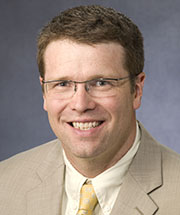Law professor writes that Supreme Court ruling allowing 'self-intervention' is in error, poses new problems
LAWRENCE — The popular television show where people confront their loved ones to help address addiction is called “Intervention,” not “Self-Intervention.” Because an intervention requires other parties. Or does it?

A University of Kansas law professor has published a new article arguing the U.S. Supreme Court ruled in error allowing states and other parties to intervene in their own legal cases. That ruling allows more than one entity — including officials not elected to represent states — to intervene in cases, split legal representation and ignore court precedent and the law, according to Lumen Mulligan, Earl B. Shurtz Research Professor of Law at KU.
The article, titled "Self-Intervention," was published earlier this month in the University of Colorado Law Review.
In North Carolina State Conference of NAACP v. Berger, the former party sued to challenge state voter identification law, arguing they violated the Voting Rights Act as well as the 14th and 15th amendments. As the state’s attorney general was defending the laws in court, North Carolina’s speaker of the House of Representatives and president pro tempore of the state senate sought to intervene in the suit, as they did not agree with the AG’s tactics. The Supreme Court ultimately ruled the speaker and president pro tempore could join the suit, even though the state was already represented by the AG.
That ruling is not only contrary to Federal Rule of Civil Procedure 24(a)(2), regarding who represents a state when sued, it presents numerous potential problems for how states can be represented in litigation at the state level and more, according to Mulligan.
“My position is that ruling is contrary to law. The fight is over who gets to be the state,” Mulligan said. “I argue the Supreme Court’s ruling is contrary to rule 24(a)(2) and the entire precedent of the court’s rulings. My position is that the attorney general and speaker of the house cannot both be the state.”

Mulligan summarized several other cases that played out in a similar fashion, with more than one party seeking to represent a state. He also reviewed the history of rule 24(a)(2) and how the SCOTUS ruling contradicts the 11th Amendment, which restricts the powers of individuals to bring action against states in court. Mulligan also examined how the Berger decision contradicts Ex parte Young doctrine, which operates as an exemption to the 11th Amendment, providing privilege to states not to be sued without consent in federal court.
Ex parte Young and its listing of specific government officials who can be parties in suits against the state is what Mulligan called “the most important Supreme Court case you’ve never heard of,” noting that it is debatably the second or third most important ruling ever handed down by the court. However, the Berger ruling contradicts that and presents numerous potential problems, especially at the state court level, he said.
“Ninety-eight percent of litigation happens in state courts. Now, states won’t be bound by Ex parte Young and for that reason shouldn’t follow the Supreme Court’s Berger decision,” Mulligan said.
Allowing more than one party to represent a state in contradiction of federal rules amounts to “self-intervention,” a term Mulligan coined to criticize the practice. By federal rule, attorneys general, elected on a statewide basis, are to represent states when sued. However, the Berger decision allows officials such as speakers of the house to join suits, which they tend to do when they have political disagreements with the AG. That presents myriad potential problems, Mulligan wrote, such as allowing politics, not law, to influence legal defense.
In states such as Wisconsin, where state officials such as the governor and AG are Democrats, but the statehouse is controlled by Republicans, that presents situations where others have sought to join suits when they disagreed with the AG’s politics and method of defense, Mulligan noted. While a problem in heavily gerrymandered states, it could also potentially be a problem within parties as well if a speaker of the house or state level representative felt the AG, a member of their party, was too liberal or too conservative. Additionally, it allows a state-level representative who only won one district equal footing with an official such as an attorney general who was elected by the entire state, according to Mulligan.
“It allows all sorts of folks who didn’t win statewide office to say, ‘I deserve to be here, too,’” Mulligan said. “It’s a mess of allowing multiple parties to argue they represent the state.”
The fallout could threaten state constitutions and create challenges to states defending their laws in courts at all levels, the author wrote. The solution would be for Congress, or one of its committees, which draft rules of federal procedure, to address the issues now presented by “self-intervention.” In the meantime, state courts should take caution not to repeat the same mistake as the Supreme Court, according to Mulligan.
“Neither the text, history nor practice under rule 24(a)(2) would allow self-intervention. The courts should not allow the Ex parte Young fiction to alter this approach. And finally, allowing legislative intervention as a matter of federal law obscures a functional separation-of-powers violation,” Mulligan wrote. “For these reasons, the courts should limit the impact of the Berger decision. The state supreme courts, exercising their independent interpretative authority over rules of procedure, should not replicate the U.S. Supreme Court’s errors. And the lower federal courts should cabin the Berger opinion as much as possible from impacting other non-corporeal entities.”
Gavel image credit: Pexels.com